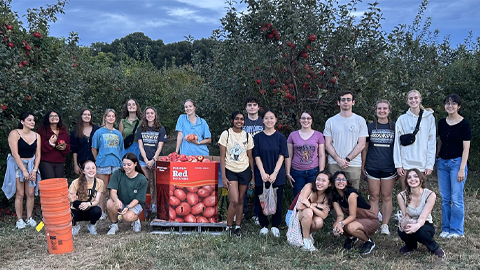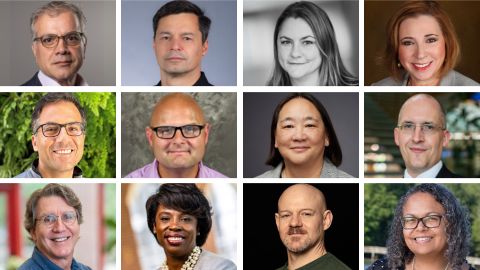Making cancer fight itself: The promise of PROTACs
Proteolysis-targeting chimeras, or PROTACs, are a new area of research in medicinal chemistry; they can leverage cancer cells’ own protein degradation machinery to target cancerous proteins.

Jianchao Zhang, a research assistant professor at Southern University of Science and Technology, or SUSTech, has always been interested in the mechanism underlying cancer development, and he became intrigued by PROTACs after learning of their potential while working in Hai Rao’s lab. Zhang and his colleagues recently discovered a PROTAC with the potential to treat chronic myeloid leukemia, a type of blood cancer.
“PROTACs are one of the most promising technologies in the biomedical field today and offer significant advantages in overcoming drug resistance and targeting undruggable targets due to their unique design and mechanism of action,” Zhang said.
In the beginning, Zhang worked primarily on cancer biology and metastasis. In 2020, Rao moved from San Antonio, Texas, to SUSTech in Shenzhen, China, where Zhang joined his lab. Zhang and colleagues began searching for chemists to collaborate with to synthesize their PROTACs. A year later, they found Lijing Fang from the Shenzhen Institute of Advanced Technology, Chinese Academy of Sciences, whose expertise in synthetic chemistry enabled them to embark on their PROTAC project in 2022.
Zhang’s journey with PROTACs was not straightforward. His team tried to target other cancerous proteins for PROTAC development, including one involved in lung cancer but encountered many obstacles.
“PROTACs are easy to design but hard to predict the outcome,” Zhang said.
After altering their design approach, they successfully developed their PROTAC, Arg-PEG1-Dasa, which can degrade the cancerous protein BCR-ABL in chronic myeloid leukemia. For the paper in the Journal of Biological Chemistry describing this work, Zhang received a JBC/ Herb Tabor Award.
What’s next for Zhang’s lab? Optimizing chemical structure and protein degradation is a critical part of drug discovery.
“We are interested in exploring the effects on (protein) degradation efficiency and rate by other amino acids,” he said. “Additionally, linker optimization is crucial for PROTACs, and we aim to modify linker types to further enhance this single amino acid PROTAC.”
Zhang and his colleagues are also working on designing PROTACs to target different types of cancer and making their PROTACs smaller to improve cellular uptake.
No FDA-approved PROTACs are yet on the market; however, several have made it to clinical trials.
“Currently, among the known drug targets, only about 20% possess active sites that can be bound by traditional small molecule inhibitors,” Zhang said. “The remaining 80% are considered undruggable or difficult to target with conventional approaches. There is a significant potential that the 80% of undruggable targets could be addressed using PROTAC technology.”
If at first you don’t succeed …
Proteolysis-targeting chimeras, or PROTACs are bifunctional molecules consisting of three structural components: a chemical entity binding to a target protein involved in cancer development (commonly referred to as a “warhead”), a chemical entity that binds to an E3 ligase (protein degrader) and a linker that connects these molecules. Together, these components help degrade cancer-promoting proteins through proximity-induced proteolysis.
PROTACs don’t need to bind to an active site or have high binding affinity to target proteins. This allows for significant flexibility in drug development.
Jianchao Zhang’s PROTAC employs the N-end rule degradation pathway, which determines that a protein’s rate of degradation depends on the identity of the N-terminal amino acid. A family of E3 ubiquitin ligases recognizes basic and hydrophobic amino acids, making them an ideal tag for PROTACs.
Using this rule, Zhang added the amino acid arginine to the FDA-approved chronic myeloid leukemia drug dasatinib with a polyethylene glycol linker. This combination degraded the cancerous protein BCR-ABL in both cells and mice.
Zhang said he was somewhat surprised when his team first observed their PROTAC-inhibiting tumor growth in a mouse model.
“It was not a given that our amino acid–based PROTAC would work,” he said. “In fact, my first set of PROTACs did not work.”
Enjoy reading ASBMB Today?
Become a member to receive the print edition four times a year and the digital edition monthly.
Learn moreGet the latest from ASBMB Today
Enter your email address, and we’ll send you a weekly email with recent articles, interviews and more.
Latest in People
People highlights or most popular articles

Meet Donita Brady
Donita Brady is an associate professor of cancer biology and an associate editor of the Journal of Biological Chemistry, who studies metalloallostery in cancer.

Glyco get-together exploring health and disease
Meet the co-chairs of the 2025 ASBMB meeting on O-GlcNAcylation to be held July 10–13, 2025, in Durham, North Carolina. Learn about the latest in the field and meet families affected by diseases associated with this pathway.

ASBMB recognizes 2025 outstanding student chapter
The Purdue group, led by Orla Hart, developed STEM outreach initiatives for low-income and minority students in Lafayette, Indiana.

ASBMB inducts 2025 honor society members
Chi Omega Lambda, which recognizes exceptional juniors and seniors pursuing degrees in the molecular life sciences, has 16 new inductees in 2025.

2025 voter guide
Learn about the candidates running for ASBMB President, Secretary, Councilor, Nominating Committee and Publications Committee.

Meet Paul Shapiro
Learn how the JBC associate editor went from milking cows on a dairy farm to analyzing kinases in the lab.

